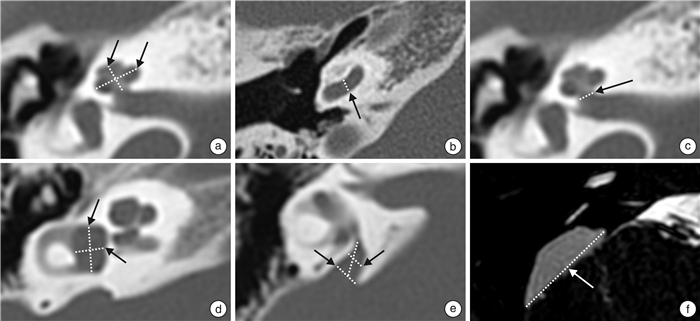Relationship between imaging features and intraoperative perilymph gusher in patients with Mondini inner ear malformation
-
摘要: 目的初步探讨Mondini畸形患儿的影像学特征与术中“井喷”的关系,为人工耳蜗植入术前预判术中“井喷”提供依据和临床指导。方法将2020年1月—2021年12月筛查的重度-极重度感音神经性聋患儿根据Sennaro lu的分类方法,严格按纳入标准分为Mondini畸形组、单纯EVA组和内耳无畸形组。对颞骨HRCT及内耳MRI进行图像后期处理,并完成各指标的测量,包括耳蜗高度、前庭导水管外口宽度等,并记录人工耳蜗植入时的“井喷”情况,分别比较三组间各指标的均值,及组内井喷组与非井喷组各指标的差异。结果Mondini畸形组、单纯EVA组和内耳无畸形组的耳蜗高度、耳蜗底周长度、蜗孔宽度、前庭长径和前庭宽径存在组间差异(P < 0.05)。Mondini畸形患儿人工耳蜗植入术中“井喷”的发生率为30.77%(8/26),井喷组的前庭导水管外口宽度[(3.10±0.74) mm]和前庭导水管中段宽度[(1.90±0.68) mm]较非井喷组宽,差异有统计学意义(P < 0.05)。单纯EVA患儿人工耳蜗植入术中“井喷”的发生率为20.00%(3/15),井喷组与非井喷组间的内淋巴囊长度比较差异有统计学意义(P < 0.05)。结论Mondini畸形患儿术中发生“井喷”的原因复杂,前庭导水管扩大明显可能为解剖基础之一,能否用于指导术前评估术中“井喷”风险,需要今后多中心大样本的临床研究进一步证实。Abstract: ObjectiveTo investigate the relationship between imaging characteristics and intraoperative perilymph gusher in patients with Mondini inner ear malformation in cochlear implantation, in order to provide basis and clinical guidance for predicting of intraoperative perilymph gusher before cochlear implantation.MethodsAccording to Sennaroglu's classification method, children with severe sensorineural hearing loss screened from January 2020 to December 2021 were divided into Mondini group, simple enlarged vestibular aqueduct group and normal inner ear group according to inclusion criteria strictly. The images of temporal bone HRCT and inner ear MRI were post-processed, some relative indicators were measured, including cochlear height and width of vestibular aqueduct, etc., and the gusher situation during cochlear implantation was recorded. The mean value of each indicator among the three groups were compared respectively, and the differences of each indicator between the gusher group and the non-gusher group were analyzed.ResultsThere were statistically significant differences in cochlear height, length of cochlear bottom turn, width of cochlear aperture, vestibular length and vestibular width among the Mondini group(24 cases), simple EVA group(15 cases) and normal inner ear group(28 cases). The incidence of gusher of Mondini group in cochlear implantation was 30.77%(8/26). The outer diameter of the VA([3.10±0.74]mm) and the middle width of the VA([1.90±0.68] mm) in the gusher group were wider than those in the non-gusher group, and the difference was statistically significant. The incidence of intraoperative gusher in patients with EVA was 20.00%(3/15), and there was statistically significant difference in the length of endolymph sac between gusher group and non-gusher group(P < 0.05).ConclusionThe causes of intraoperative perilymph gusher in patients with Mondini inner ear malformation are complex. The enlarged vestibular aqueduct may be one of the anatomical basis. Whether it can be used to guide the preoperative assessment of the risk of intraoperative perilymph gusher need to be further confirmed by a large sample of clinical research from multiple centers in the future.
-

-
表 1 Mondini畸形组、单纯EVA组和内耳无畸形组的内耳各指标比较
mm,X±S 指标 Mondini畸形组(48耳) 单纯EVA组(30耳) 内耳无畸形组(56耳) P值 耳蜗高度 4.05±0.43 3.82±0.47 3.16±0.27 0.001 耳蜗底周长度 8.05±0.66 7.31±0.87 6.21±0.82 <0.001 耳蜗底周管径 1.77±0.27 1.81±0.21 1.56±0.16 0.086 蜗孔宽度 1.66±0.47 1.58±0.30 1.42±0.29 0.004 前庭长径 6.08±0.39 5.92±0.38 5.77±0.41 0.001 前庭宽径 3.55±0.39 3.59±0.43 2.87±0.29 <0.001 前庭导水管中段宽度 1.56±0.58 1.59±0.70 0.74±0.15(14耳) 0.422 前庭导水管外口宽度 2.38±0.90 2.33±1.08 0.67±0.09(9耳) 0.499 内淋巴囊长径 14.66±6.53 16.53±6.51 - 0.696 内淋巴囊宽径 11.11±2.87 11.66±4.57 - 0.127 注:“-”指内淋巴囊未显影,未测量。 表 2 Mondini畸形患儿中井喷组和非井喷组的内耳各指标比较
mm,X±S 指标 井喷组(8耳) 非井喷组(18耳) P值 耳蜗高度 4.03±0.62 4.01±0.37 0.244 耳蜗底周长度 7.91±0.39 8.04±0.74 0.636 耳蜗底周管径 1.68±0.30 1.81±0.25 0.263 蜗孔宽度 1.49±0.58 1.69±0.47 0.376 前庭长径 6.31±0.39 6.00±0.32 0.051 前庭宽径 3.39±0.51 3.58±0.48 0.384 前庭导水管中段宽度 1.90±0.68 1.42±0.42 0.043 前庭导水管外口宽度 3.10±0.74 2.02±0.79 0.004 内淋巴囊长径 18.92±3.47 14.50±6.41 0.109 内淋巴囊宽径 12.77±2.87 9.67±3.71 0.071 表 3 单纯EVA患儿中井喷组和非井喷组的内耳各指标比较
mm,X±S 指标 井喷组(3耳) 非井喷组(12耳) P值 耳蜗高度 4.12±0.76 3.81±0.32 0.266 耳蜗底周长度 1.82±0.09 1.80±0.26 0.884 耳蜗底周管径 7.78±0.11 7.36±0.95 0.476 蜗孔宽度 1.69±0.33 1.61±0.37 0.737 前庭长径 5.69±0.92 5.95±0.50 0.386 前庭宽径 3.62±0.76 3.52±0.31 0.719 前庭导水管中段宽度 1.59±0.13 1.46±0.71 0.756 前庭导水管外口宽度 2.61±0.66 2.25±1.01 0.572 内淋巴囊长径 13.44±2.28 19.51±3.76 0.021 内淋巴囊宽径 10.70±0.62 13.19±3.24 0.222 -
[1] Jackler RK, Luxford WM, House WF. Congenital malformations of the inner ear: a classification based on embryogenesis[J]. Laryngoscope, 1987, 97(3 Pt 2 Suppl 40): 2-14.
[2] Sennaroǧlu L, Bajin MD. Classification and Current Management of Inner Ear Malformations[J]. Balkan Med J, 2017, 34(5): 397-411. doi: 10.4274/balkanmedj.2017.0367
[3] Dewan K, Wippold FJ 2nd, Lieu JE. Enlarged vestibular aqueduct in pediatric sensorineural hearing loss[J]. Otolaryngol Head Neck Surg, 2009, 140(4): 552-558. doi: 10.1016/j.otohns.2008.12.035
[4] Loundon N, Leboulanger N, Maillet J, et al. Cochlear implant and inner ear malformation. Proposal for an hyperosmolar therapy at surgery[J]. Int J Pediatr Otorhinolaryngol, 2008, 72(4): 541-547. doi: 10.1016/j.ijporl.2008.01.004
[5] Sennaroglu L, Saatci I. A new classification for cochleovestibular malformations[J], Laryngoscope, 2002, 112(12): 2230-2241. doi: 10.1097/00005537-200212000-00019
[6] 李幼瑾, 杨军, 李蕴. 感音神经性聋患儿中先天性内耳畸形的构成、影像学及临床听力学特征[J]. 临床耳鼻咽喉头颈外科杂志, 2011, 25(1): 1-5. https://www.cnki.com.cn/Article/CJFDTOTAL-LCEH201101002.htm
[7] 刘贝贝, 徐百成, 陈迟, 等. 先天性内耳畸形致自发性脑脊液耳漏1例报告[J]. 中华耳科学杂志, 2018, 16(2): 258-260. https://www.cnki.com.cn/Article/CJFDTOTAL-ZHER201802026.htm
[8] Jackler RK, De La Cruz A. The large vestibular aqueduct syndrome[J]. Laryngoscope, 1989, 99(12): 1238-1243.
[9] Goldfeld M, Glaser B, Nassir E, et al. CT of the ear in Pendred syndrome[J]. Radiology, 2005, 235(2): 537-540. doi: 10.1148/radiol.2352031583
[10] 董宝成, 张道行, 张岩昆, 等. "井喷"在内耳畸形人工耳蜗植入术中的发生率[J]. 临床耳鼻咽喉头颈外科杂志, 2007, 21(13): 583-585. https://www.cnki.com.cn/Article/CJFDTOTAL-LCEH200713005.htm
[11] Zheng Y, Schachern PA, Cureoglu S, et al. The shortened cochlea: its classification and histopathologic features[J]. Int J Pediatr Otorhinolaryngol, 2002, 63(1): 29-39. doi: 10.1016/S0165-5876(01)00642-5
[12] Suk Y, Lee JH, Lee KS. Surgical outcomes after cochlear implantation in children with incomplete partition type I: comparison with deaf children with a normal inner ear structure[J]. Otol Neurotol, 2015, 36(1): e11-17. doi: 10.1097/MAO.0000000000000606
[13] Kontorinis G, Goetz F, Giourgas A, et al. Radiological diagnosis of incomplete partition type I versus type Ⅱ: significance for cochlear implantation[J]. Eur Radiol, 2012, 22(3): 525-532. doi: 10.1007/s00330-011-2301-5
[14] 卢宇涵, 李佳楠, 孙丽, 等. 内耳不完全分隔Ⅲ型(IP-Ⅲ)畸形病例分析[J]. 中华耳科学杂志, 2018, 16(4): 451-457. doi: 10.3969/j.issn.1672-2922.2018.04.005
[15] 刘兰, 费静, 陶美慧, 等. 内耳发育畸形患者人工耳蜗植入术后的疗效分析[J]. 中国耳鼻咽喉颅底外科杂志, 2019, 25(2): 152-156. https://www.cnki.com.cn/Article/CJFDTOTAL-ZEBY201902013.htm
[16] Kim M, Kim J, Kim SH, et al. Hemorrhage in the endolymphatic sac: a cause of hearing fluctuation in enlarged vestibular aqueduct[J]. Int J Pediatr Otorhinolaryngol, 2011, 75(12): 1538-1544. doi: 10.1016/j.ijporl.2011.09.002
[17] Xu H, Liang FY, Chen L, et al. Evaluation of the utricular and saccular function using oVEMPs and cVEMPs in BPPV patients[J]. J Otolaryngol Head Neck Surg, 2016, 45: 12. doi: 10.1186/s40463-016-0125-7
[18] 鲁海平, 魏兴梅, 王杰, 等. 单纯前庭导水管扩大行人工耳蜗植入患儿临床特征回顾性研究[J]. 中国耳鼻咽喉头颈外科, 2016, 23(8): 443-447, 453. https://www.cnki.com.cn/Article/CJFDTOTAL-EBYT201608005.htm
[19] 方哲明, 娄昕, 兰兰, 等. 大前庭导水管综合征内淋巴囊和前庭导水管MRI信号特征及其临床意义[J]. 中华放射学杂志, 2012, 46(1): 9-12. doi: 10.3760/cma.j.issn.1005-1201.2012.01.003
-





 下载:
下载: